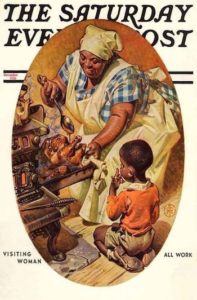
Thanksgiving Magazine Cover, 1936
(Saturday Evening Post)
*Thanksgiving, 1777, and African American history are briefly addressed on this date.
That year, the turning point of America’s Revolutionary War occurred with victory over the British at Saratoga. The Continental Congress delivered a decree for the 13 colonies to give thanks. Black slaves also celebrated throughout the region; the tradition continued as a custom of rejoicing for the rain to break droughts for a plentiful harvest.
Thanksgiving expression for the American Black community began as a church-based celebration. Black pastors often gave sermons that could be heard loud and clear through the many small Black churches. The sermons would be about struggles, hopes, fears, and triumphs. The sermons usually grieved the institution of slavery and the suffering of the black people and often pleaded that an awakening of a slave-free America would someday come soon.
In October 1863, months after signing the Emancipation Proclamation earlier in the year, President Abraham Lincoln signed a proclamation to officially celebrate the Thanksgiving holiday. Before the proclamation, Thanksgiving was also a period when slaves would often try to escape due to the ending of crop season; however, the new law morphed into a time when newly freed Blacks could come together.
Also, after deliverance from American slavery on November 30, 1876 (Thanksgiving), African Methodist Episcopalian cleric Reverend Benjamin Arnett preached to a predominantly Black congregation with the following Bible-inspired words:…we call on all American citizens to love their country and look not on the sins of the past, but arming ourselves for the conflict of the future, girding ourselves in the habiliments of Righteousness, march forth with the courage of a Numidian lion and with the confidence of a Roman Gladiator, and meet the demands of the age, and satisfy the duties of the hour.”